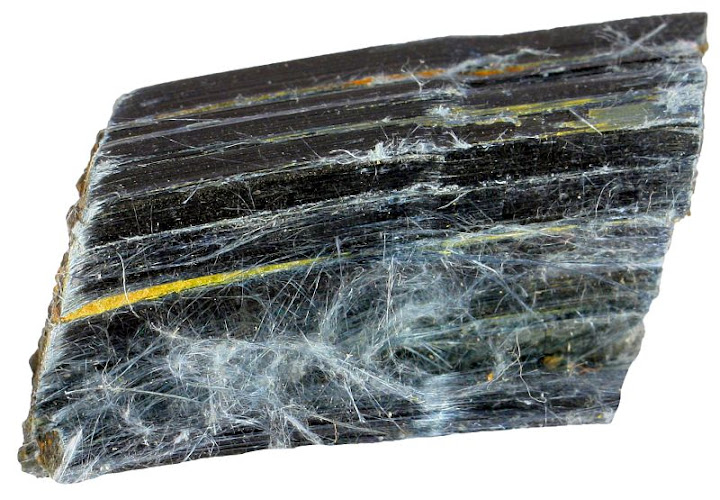Crocidolite is a fibrous variety of riebeckite. Riebeckite is a silicate mineral belonging to the amphibole group. Usually I do not devote an entire post to just a variety of one mineral but in this case I believe we have a fairly good reason to pay more attention to it.
Crocidolite is one of the asbestos minerals, it is also known as the blue asbestos. Blue color sets it apart from other asbestiform minerals. Crocidolite is a relatively rare mineral with very restricted occurrence, it is found in metamorphosed iron formations as slender and flexible fiber bundles.
The health risks associated with asbestos are generally well known. A lot less known is the fact that asbestos is not a single mineral, not even a single mineral group. All asbestos minerals are fibrous. This defining property of all the asbestos minerals makes them potentially hazardous ? inhaled asbestos fibers may damage the lungs and are known to cause serious diseases as asbestosis, lung cancer, and mesothelioma (a rare form of lung cancer mostly caused by the exposure to asbestos).
However, the nature of fibers of different asbestos minerals varies. By far the most widely used asbestos mineral is chrysotile which belongs to the serpentine mineral group. It is green in color and its fibers are actually microscopic rolled sheets (serpentine is a sheet silicate just like clay minerals and micas). The evidence that these rolled sheets cause aforementioned diseases is less convincing as is the case with amphiboles. It is even more important to understand that a low-level exposure or even a single high-level exposure to asbestos, no matter what type, is very unlikely to cause a serious disease. It takes a long-term exposure to fibers to cause harm. I would be concerned if I were a miner or a construction worker but otherwise I can not find a justification for wasting enormous amount of money to replace construction materials which are in many cases somewhat difficult to breathe in.

A sample of crocidolite from South Africa showing the fibrous nature of the mineral. The width of the sample is 3 cm.
But what about crocidolite? What makes it different and do we have a reason to be concerned? First of all, there is a fundamental structural difference between a sheet silicate serpentine and a chain silicate amphibole. Amphiboles are composed of many slender and often sharp chains which seem to cause much more harm to human lungs. There are many different amphibole minerals which have fibrous varieties but crocidolite seems to be among the most hazardous of them.
Ironically, it often happens that inventions which are at least partly meant to protect our health do just the opposite. Remember margarine which was long believed to be less harmful to our health than butter which is rich in saturated fats. Only recently we discovered that hydrogenated vegetable fats are actually much worse. Something similar happened with crocidolite as well. Cigarette filters where invented to reduce the amount of tar and particulate material inhaled by smokers. However, such filters do more harm than good if crocidolite is used in their composition. This was the case with Kent?s Micronite filters from 1952 to 1956. It only makes me wonder what are the killers of today which we are used to think as our protectors. There are definitely many.
Source: http://www.sandatlas.org/2012/08/crocidolite/?utm_source=rss&utm_medium=rss&utm_campaign=crocidolite
discovery shuttle allure jane goodall saturday night fever glamping forgetting sarah marshall taraji p. henson

No comments:
Post a Comment
Note: Only a member of this blog may post a comment.